Nutty Concerns: Can Cats Eat Chestnuts Safely? Vet Explains the Risks (True vs. Horse Chestnuts)
- 15 Apr 2025 11:02
As the autumn leaves turn and holiday seasons approach, chestnuts often make an appearance in our kitchens and homes. Roasted over an open fire or incorporated into festive dishes, their unique, slightly sweet flavor is a seasonal treat for many. Seeing these nuts around the house, a curious cat owner might naturally wonder: can cats eat chestnuts? Are these starchy nuts a safe nibble, or do they pose potential dangers to our feline friends?
The answer requires a crucial distinction and careful consideration. **True chestnuts** (*Castanea* species) are generally considered non-toxic to cats, but they are still not recommended as treats due to their nutritional profile and potential hazards. However, **horse chestnuts** (*Aesculus* species), which look somewhat similar, are **highly toxic** and dangerous. This comprehensive guide, adhering to E-E-A-T standards (Experience, Expertise, Authoritativeness, Trustworthiness) and reviewed for veterinary accuracy, will delve into the differences between these "nuts," explore the risks and minimal benefits of true chestnuts for cats, highlight the severe dangers of horse chestnuts, and provide essential safety advice.
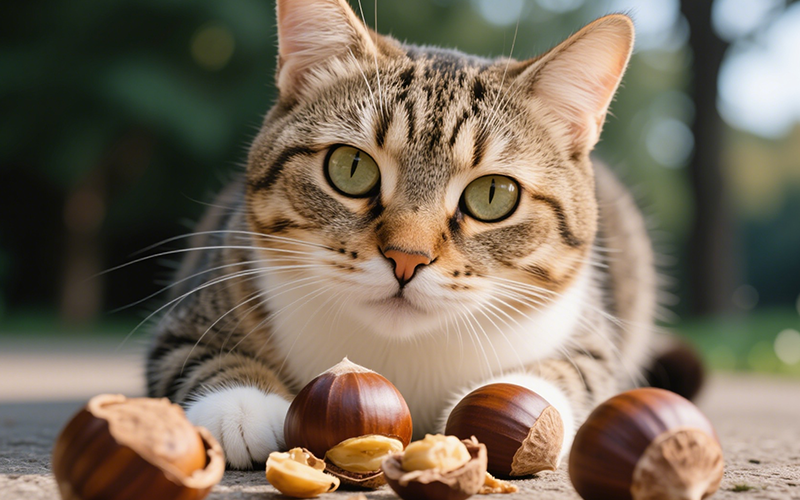
What are True Chestnuts (*Castanea* species)?
When we talk about edible chestnuts used in cooking (like those roasted or used in stuffing), we are referring to species from the *Castanea* genus, such as:
American Chestnut (*Castanea dentata* - largely wiped out by blight)
European Chestnut / Sweet Chestnut (*Castanea sativa*)
Chinese Chestnut (*Castanea mollissima*)
Japanese Chestnut (*Castanea crenata*)
Key characteristics:
Grow inside a very spiny, burr-like husk (involucre), usually containing 1-3 nuts.
The nut itself has a pointed tip.
Nutritionally different from other nuts: lower in fat, higher in starch/carbohydrates, contain Vitamin C (which degrades with cooking), B vitamins, minerals, and fiber.
Typically roasted or boiled before eating.
It is these *Castanea* species that are generally listed as non-toxic by pet poison control resources.
**CRITICAL WARNING:** Horse Chestnuts (*Aesculus* species) are TOXIC!
This distinction cannot be emphasized enough. Horse chestnuts, sometimes called "conkers," look superficially similar to edible chestnuts but belong to a completely different plant family (*Sapindaceae*) and are **poisonous** to cats, dogs, and humans if ingested.
Appearance:** Grow in a fleshy, less spiny or bumpy green husk, usually containing only one larger, rounder, shinier nut without a distinct point.
Toxic Compound:** Contain **aesculin** (also spelled esculin), a glycosidic saponin.
Toxicity:** All parts of the horse chestnut plant (nuts, leaves, bark, flowers) are toxic. Aesculin causes gastrointestinal upset and potentially more severe signs.
Symptoms of Horse Chestnut Poisoning:** Ingestion can cause:
Severe Vomiting
Diarrhea
Excessive Drooling (Hypersalivation)
Abdominal Pain
Loss of Appetite
Lethargy / Depression
Muscle Twitching
Dilated Pupils
In severe cases (usually requiring ingestion of larger amounts): Weakness, incoordination, potential neurological signs, paralysis, coma.
**Never allow your cat to play with or ingest horse chestnuts.** They are common in parks and landscaping. If you suspect ingestion, it's a **veterinary emergency.**
Feline Nutrition vs. Nuts: An Unsuitable Match
Before even considering true chestnuts, remember the basics of feline nutrition. Cats are **obligate carnivores**. Their bodies are designed for a diet high in animal protein and fat, with minimal carbohydrates.
Nutrient Needs:** Require taurine, arachidonic acid, pre-formed Vitamin A, etc., all derived efficiently from meat.
Carbohydrate Digestion:** Have limited ability to digest starches and complex carbohydrates found abundantly in chestnuts.
Plant Protein:** Plant-based proteins (like those in nuts) are incomplete and poorly utilized compared to animal protein.
Chestnuts, being primarily starch and carbohydrates with plant protein and fiber, do not align with a cat's core nutritional requirements.
Can Cats Eat *True* Chestnuts Safely? (The Nuanced Answer)
Focusing now only on the edible *Castanea* species:
Non-Toxic:** As confirmed by sources like the ASPCA, true chestnuts are **not considered toxic** to cats. Ingesting a small amount of plain, cooked chestnut is unlikely to cause poisoning.
**Not Recommended:** Despite being non-toxic, they are **not recommended** as treats or food supplements for several key reasons:
Nutritionally Inappropriate:** High in carbohydrates/starch, low in essential feline nutrients. Offers empty calories.
Digestive Upset Potential:** The high starch and fiber content can be difficult for cats to digest, leading to gas, bloating, diarrhea, or vomiting.
Choking Hazard:** Whole or large pieces of chestnut (raw or cooked) pose a significant choking risk due to their size and firm texture.
Intestinal Obstruction Risk:** If swallowed whole or in large chunks, chestnuts could potentially cause a blockage in the digestive tract.
Preparation Dangers:** Chestnuts prepared for humans often contain harmful ingredients like salt, butter, sugar, or spices.
Therefore, while not poisonous like their horse chestnut cousins, true chestnuts offer minimal benefit and carry notable risks, making them an unsuitable food choice for felines.
Potential (Minimal) Benefits of True Chestnuts?
Are there any redeeming qualities for cats? Very few:
Fiber:** Might theoretically add some fiber, but the amount needed for benefit would likely cause digestive upset due to the starch content. Better fiber sources exist (like plain pumpkin puree, used appropriately).
The lack of usable nutrients and the potential downsides far outweigh any theoretical minor benefit.
Risks of Feeding True Chestnuts to Cats
Even though non-toxic, these risks make true chestnuts a poor choice:
1. Gastrointestinal Upset
High Starch/Carbs:** Cats digest carbohydrates poorly. Undigested starch ferments in the gut, leading to gas, bloating, diarrhea, and abdominal discomfort.
Fiber Content:** While fiber can be good, too much plant fiber, especially from a source cats aren't adapted to, can also cause digestive upset.
2. Choking Hazard & Intestinal Obstruction - **SIGNIFICANT RISK**
Size & Texture:** Chestnuts are relatively large and firm, even when cooked. Cats often don't chew thoroughly.
Risk:** A whole or large piece can easily become lodged in the throat (choking emergency) or cause a blockage in the intestines (requiring emergency surgery). This is a major safety concern.
3. High Carbohydrate Content & Calories
Nutritionally Empty:** Provides calories primarily from carbs, offering little essential nutrition for a carnivore.
Weight Gain:** Contributes unnecessary calories, potentially leading to obesity if fed regularly.
Blood Sugar:** High starch intake can impact blood sugar levels, a concern for diabetic or pre-diabetic cats.
4. Dangers from Preparation Methods
Chestnuts are rarely eaten completely plain by humans.
Roasting:** Often done with salt and/or butter. Excess salt is dangerous (sodium toxicity), and high fat from butter risks GI upset and pancreatitis.
Boiling:** May be done with salt.
Candied/Sweetened:** High sugar content is unhealthy.
Stuffing/Dishes:** Often contain **toxic onions, garlic,** fats, salt, and spices.
Never feed cats chestnuts prepared with these additives.
5. Mold Risk
Improper Storage:** Chestnuts stored improperly can develop mold.
Mycotoxins:** Moldy nuts produce mycotoxins, which can cause severe illness (tremors, seizures, organ damage) if ingested. Never feed moldy nuts of any kind.
Raw vs. Cooked True Chestnuts for Cats
Raw Chestnuts:** Harder texture increases the choking/obstruction risk. May be even more difficult to digest than cooked. Contain tannins which could potentially cause mild irritation. Not recommended.
Cooked Chestnuts (Plain):** Softer texture slightly reduces (but doesn't eliminate) the choking risk. Starch is slightly more digestible but still inappropriate. Still high carb/low value. If offering against advice, *plain* cooked is marginally safer than raw, but only in minuscule, mashed amounts.
What About Chestnut Products (Flour, Puree)?
Chestnut Flour:** High in carbohydrates. Baked goods made with it usually contain other unsafe ingredients (sugar, fat, etc.). Not suitable.
Chestnut Puree:** Often sweetened or contains other additives. Plain, unsweetened puree would still be high carb/low value and risk GI upset. Not recommended.
"My Cat Ate a Chestnut!" - Action Plan
Your response depends critically on identifying the type:
If You Suspect HORSE CHESTNUT Ingestion:
**IMMEDIATE VETERINARY EMERGENCY.** This is potentially life-threatening.
Call your vet or emergency clinic *and* Pet Poison Helpline immediately.
Provide plant ID, estimated amount, time of ingestion, and symptoms.
Transport your cat to the vet ASAP. Do NOT induce vomiting unless instructed.
If Your Cat Ate a TRUE CHESTNUT (*Castanea*):
Identify Preparation:** Was it plain, raw, cooked, salted, part of a dish?
Assess Amount & Size:** How much was eaten? Was it whole or a small piece?
If Plain, Cooked, Tiny Piece:** Monitor closely for 24-48 hours for vomiting, diarrhea, gas, lethargy, or signs of choking/discomfort. Call your vet if symptoms develop.
If Whole Chestnut, Large Piece, or Raw:** Call your vet immediately due to high risk of choking or intestinal obstruction, even if non-toxic. They may advise monitoring or recommend diagnostics (like X-rays) depending on the situation.
If Salted/Seasoned/Part of Dish:** Call your vet immediately due to risks of salt toxicity or toxic ingredients (onion, garlic, etc.).
Safer Alternatives: Species-Appropriate Treats
Instead of risky nuts, choose treats cats can safely enjoy:
Plain Cooked Meat:** Small bits of unseasoned chicken, turkey, lean beef.
Commercial Cat Treats:** High-quality, meat-based options.
Freeze-Dried Meat Treats:** Single-ingredient protein snacks.
Lickable Treats / Meat Slurries.**
Dental Treats for Cats.**
These align with their nutritional needs, unlike cats eating chestnuts.
Expert Veterinary Opinion on Chestnuts for Cats
The veterinary consensus is clear:
**Horse Chestnuts (*Aesculus*) are toxic** and ingestion is an emergency.
**True Chestnuts (*Castanea*) are non-toxic** but **not recommended** due to being nutritionally inappropriate (high carb, low essential nutrients) for obligate carnivores.
The primary risks with true chestnuts are **gastrointestinal upset** (from starch/fiber) and **choking or intestinal obstruction** (from size/texture).
Chestnuts prepared for human consumption often contain **dangerous levels of salt, fat, sugar, or toxic seasonings**.
Prevention and offering species-appropriate treats are the safest course.
Summary Table: Cats and Chestnut Safety
| Aspect | Safety Information & Recommendations |
| Can Cats Eat TRUE Chestnuts? (*Castanea*) | Non-toxic, but **NOT recommended.** Nutritionally inappropriate, risks GI upset & choking/obstruction. |
| HORSE Chestnuts (*Aesculus*) | **TOXIC / DANGEROUS.** Contain aesculin. Cause severe GI and potential neurological signs. **Veterinary Emergency if ingested.** |
| Risks of True Chestnuts | GI Upset (High Carb/Fiber), **Choking Hazard**, **Intestinal Obstruction**, Empty Calories, Preparation Dangers (Salt/Fat/Sugar/Spices), Mold. |
| Nutritional Value (True Chestnut) | Negligible/Inappropriate for cats (high carb, low essential nutrients). |
| Raw vs. Cooked (True Chestnut) | Cooked is slightly softer (less choking risk) but still unsuitable (high carb). Avoid both. |
| Action if Eaten | **Horse Chestnut -> IMMEDIATE EMERGENCY VET.** True Chestnut -> Call Vet (Obstruction/Choking risk, GI upset risk, potential added ingredients). |
| Recommendation | **Avoid feeding any chestnuts.** Keep Horse Chestnuts completely inaccessible. Offer safe, species-appropriate treats. |
Need Pet Safety Info Fast? PettureX Can Provide Support!
Distinguishing safe items from dangerous ones, like true chestnuts versus toxic horse chestnuts, is vital for cat safety. If your cat eats something unknown or potentially harmful, or shows sudden signs of illness, having access to quick information is crucial while you contact your veterinarian – your primary resource for diagnosis and treatment.
The PettureX App offers helpful features for pet parents in need:
24/7 AI Vet Consultation: Get immediate AI-powered answers to urgent questions ("What does horse chestnut poisoning look like in cats?") or guidance on assessing symptoms like vomiting or difficulty breathing.
Image Recognition Technology: Might assist with identifying common items or assessing visible symptoms (always confirm with your vet).
AI-Powered Symptom Checker: Input your cat's symptoms for an AI analysis of potential causes, including poisoning or obstruction, aiding communication with your vet or emergency services.
Comprehensive Pet Health Database: Quickly access information on toxic substances, common emergencies, first aid awareness, and feline health.
PettureX provides convenient AI-driven support, acting as a valuable resource alongside the essential, personalized care from your veterinarian, especially when facing potential emergencies.
Conclusion: Chestnuts are Best Left Off the Feline Menu
In conclusion, while true edible chestnuts (*Castanea* species) are not toxic to cats, the answer to "can cats eat chestnuts?" is still a firm recommendation to avoid them. They are nutritionally unsuitable for obligate carnivores due to their high carbohydrate content and lack of essential feline nutrients. More importantly, they pose significant risks of gastrointestinal upset and, crucially, choking or intestinal obstruction.
Furthermore, the danger of mistaking them for **highly toxic horse chestnuts (*Aesculus* species)** is a critical concern. Chestnuts prepared for human consumption also introduce risks from added salt, fat, sugar, and potentially lethal seasonings.
Protect your cat by keeping all chestnuts, especially horse chestnuts, out of reach and by offering only safe, species-appropriate treats. If accidental ingestion occurs, contact your veterinarian immediately, being sure to differentiate between the types of chestnuts if possible. When it comes to your cat's health, it's always best to err on the side of caution and skip the nuts.
Related
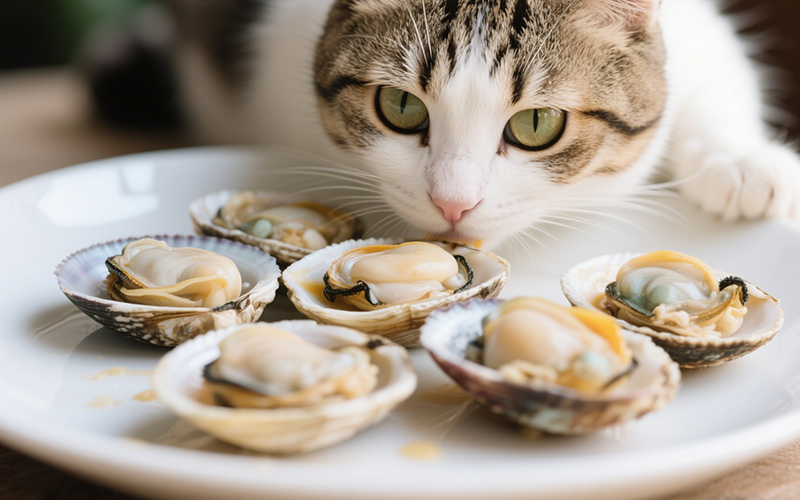
Seafood Surprise: Can Cats Eat Clams Safely? (Vet-Reviewed Risks & Guide)
- 15 Apr 2025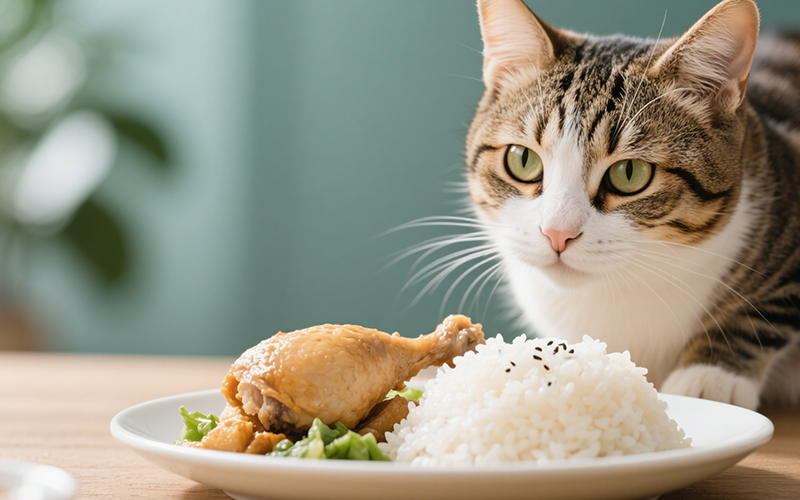
Chicken & Rice for Cats: Safe Treat or Dietary Danger? (Vet-Reviewed Guide)
- 15 Apr 2025
Creepy Crawly Cuisine? Can Cats Eat Centipedes Safely? (Vet-Reviewed Warning)
- 15 Apr 2025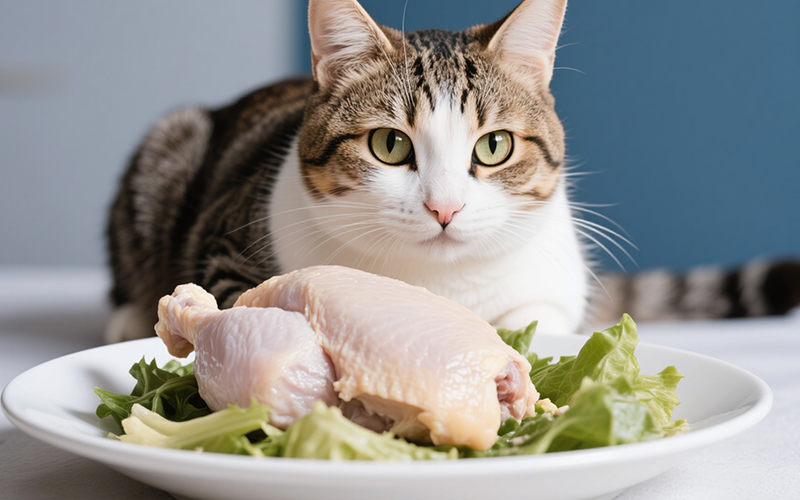
Boiled Chicken for Cats: A Purrfectly Safe Treat or Potential Pitfall? (Vet-Reviewed Guide)
- 15 Apr 2025
The Gourd Guide: Can Cats Eat Canned Pumpkin Safely? Vet-Reviewed Benefits & Risks
- 15 Apr 2025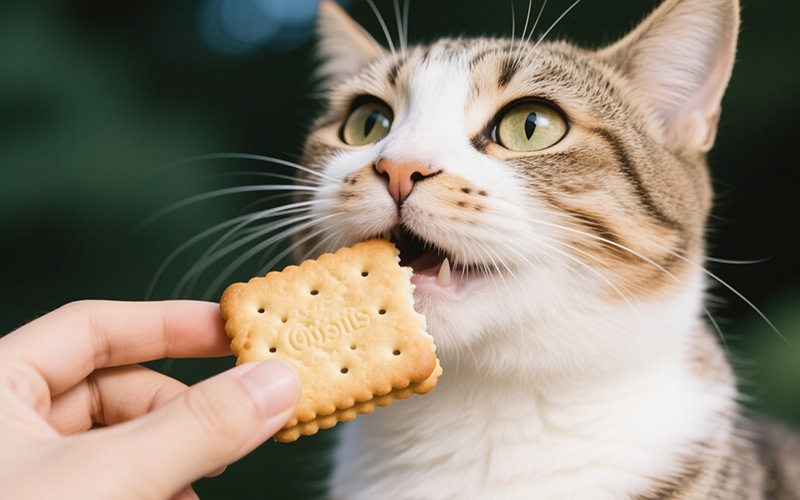
The Crumbly Truth: Can Cats Eat Biscuits Safely? Vet Warns of Hidden Dangers
- 15 Apr 2025
Beef Liver for Cats: Nutrient Powerhouse or Risky Treat? (Vet-Reviewed Safety Guide)
- 15 Apr 2025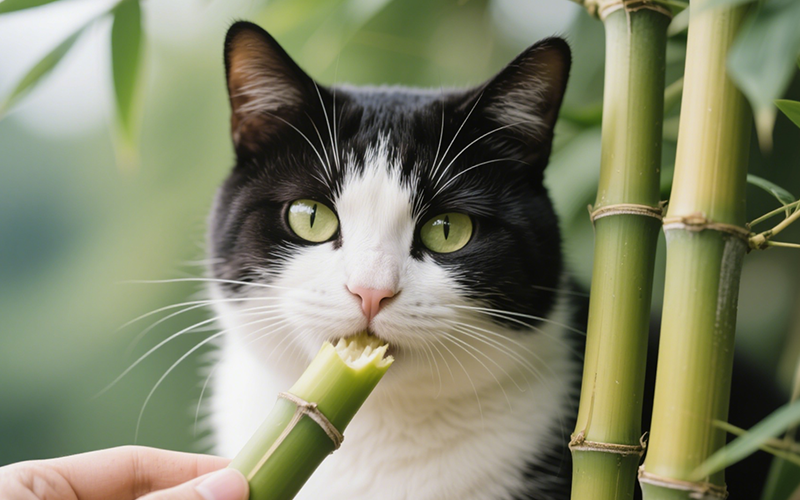
Green Stalks & Curious Cats: Can Cats Eat Bamboo Safely? (Vet-Reviewed Guide)
- 15 Apr 2025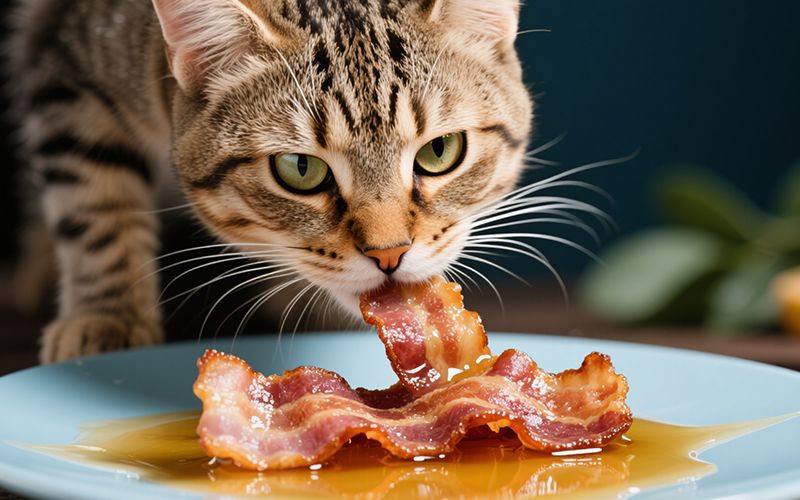
Fat Trap Alert: Can Cats Eat Bacon Grease Safely? (Vet-Reviewed Dangers)
- 15 Apr 2025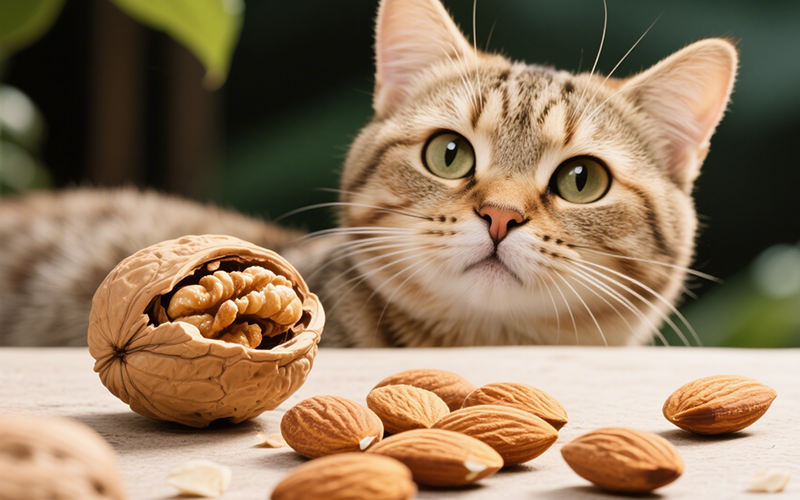
Nutty Notion or Nasty Nibble? Can Cats Eat Almonds Safely? (Vet-Reviewed Guide)
- 14 Apr 2025
